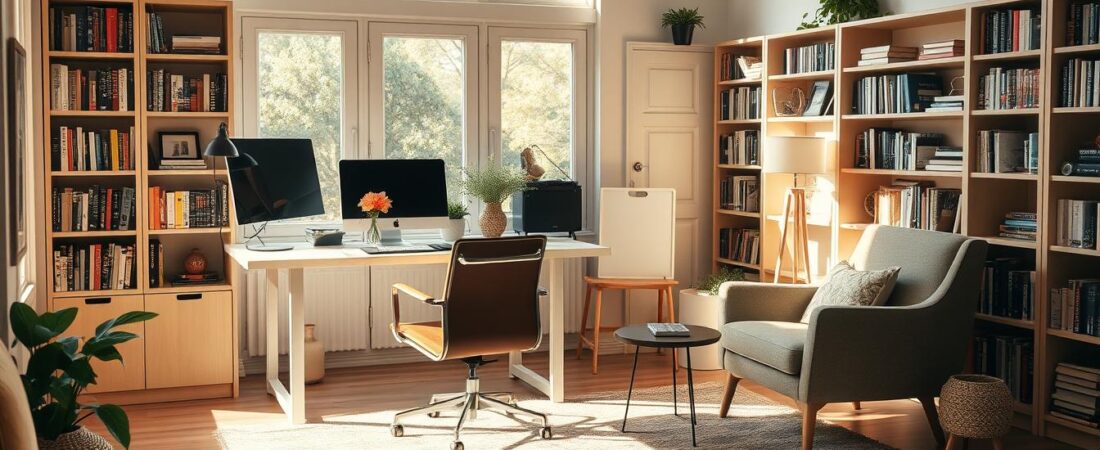Remote work has become common, making a home office essential. If you have little space, turning your living room into a workspace is a smart choice. A well-thought-out living room workspace can make you more productive and comfortable.
To create a functional workspace in your living area, planning is key. You must find a balance between work and relaxation while keeping the atmosphere cozy. A well-set home office helps you stay on track and avoid distractions.
Key Takeaways
- Assess your living room space to determine the best layout for your workspace.
- Choose a comfortable and ergonomic chair for long working hours.
- Use storage solutions to keep your workspace organized and clutter-free.
- Consider the lighting and color scheme to create a productive atmosphere.
- Set boundaries between your work and leisure spaces.
Assessing Your Living Room’s Potential
Before you start your home office, check out your living room. Look at its layout and features. This will help you make a space that works well and helps you get things done.
Identifying Available Space
First, measure your room and see where you can put your workspace. Think about the room’s size, where doors are, and any things that might get in the way.
Evaluating Natural Light Sources
Light from the sun can really help you stay focused. Look at the light in your room and pick a spot for your desk. Having your desk by a window can make you feel better and more awake.
Considering Noise Factors
Too much noise can make it hard to concentrate. Check how loud your room is, like if it’s close to the street. If it’s too loud, you might need to use special tools to block out the sound.
| Factor | Ideal Condition | Solution for Less-Than-Ideal Conditions |
|---|---|---|
| Available Space | Ample space for desk and storage | Utilize vertical space with wall-mounted shelves |
| Natural Light | Direct sunlight | Use mirrors to reflect natural light or invest in high-quality lamps |
| Noise Level | Quiet environment | Implement noise-cancelling solutions or soundproofing |
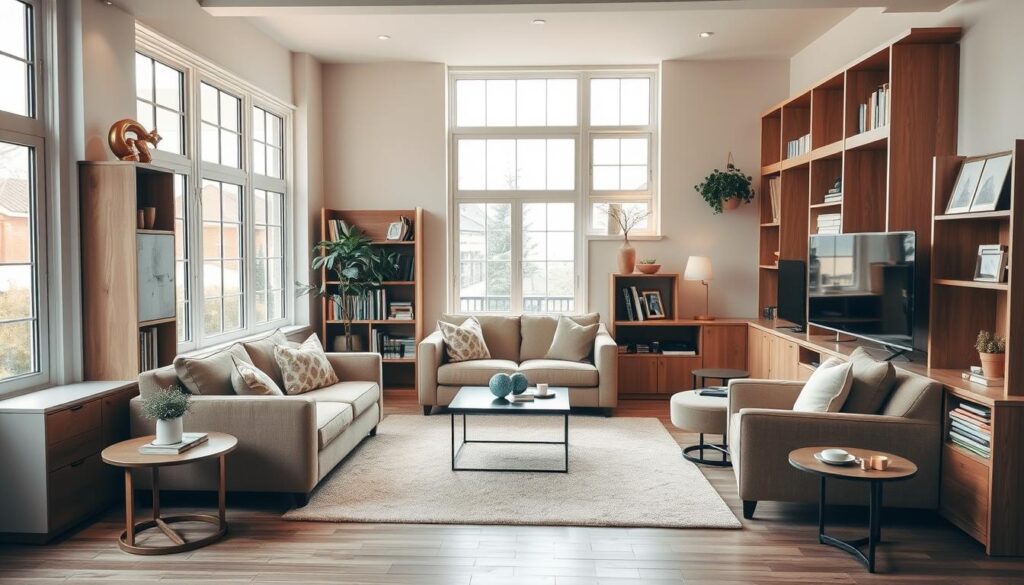
By looking closely at your living room and using small space solutions, you can make a workspace that’s both useful and cozy.
Creating a Functional Workspace in Your Living Area
Turning your living area into a workspace starts with knowing what you need. You must think about several important factors. These will make your workspace both functional and comfortable.
Defining Work Requirements
First, figure out what kind of work you do. Think about the tools and space you need to be productive. For example, if you use a computer, you’ll need a desk for your monitor, keyboard, and other work-from-home essentials like a printer or scanner.
- List the tasks you perform daily.
- Identify the tools and equipment necessary for these tasks.
- Consider the storage needs for your work materials.
Balancing Work and Living Functions
It’s important to keep your work and living areas separate. Choose ergonomic furniture that meets your work needs but also fits your living room. For instance, a small desk or a storage ottoman can serve two purposes.
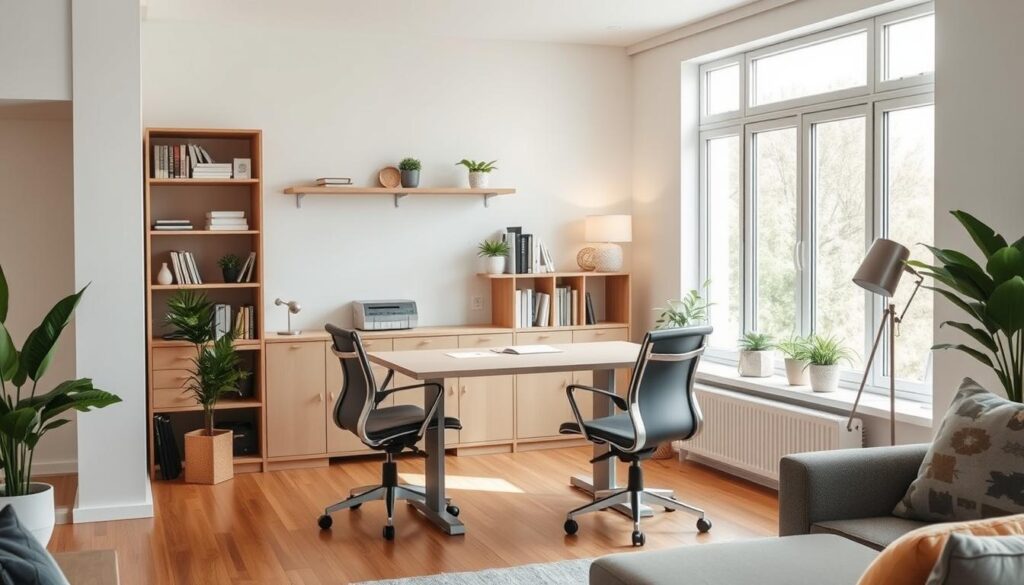
Setting Boundaries Between Spaces
Clear boundaries between your workspace and living area help you stay focused. Room dividers, curtains, or different lighting can mark your workspace.
- Use a room divider to create a physical barrier.
- Employ different lighting for your workspace to distinguish it from the rest of the room.
- Consider the color scheme to visually separate the areas.
By defining your work needs, balancing work and living, and setting boundaries, you can make a workspace in your living area. This will boost your productivity and well-being.
Selecting the Ideal Location
Setting up a home office in your living room starts with picking the best spot. The right place boosts productivity and cuts down on distractions.
Corner Workspace Solutions
Using a corner for your workspace is smart. Corner desks fit perfectly in corners. This saves space and keeps the room open.
Window-Adjacent Setups
Having your desk by a window is great. It brings in natural light and views. But, you need to avoid glare on your screen.
Room Divider Approaches
A room divider can help keep your workspace separate. This reduces distractions and makes your area more focused. Room dividers come in many styles, from simple screens to fancy shelving units.
| Location | Benefits | Considerations |
|---|---|---|
| Corner | Space-efficient, minimizes clutter | Potential for feeling isolated |
| Window-Adjacent | Natural light, view | Glare on screens, possible distraction |
| Room Divider | Separates workspace, reduces distractions | Extra cost, space needed for divider |

Essential Furniture for Your Living Room Office
To mix work and fun well, you need the right furniture. Choosing pieces that work well and look good is key for a living room office.
Desk Options for Limited Spaces
In small living rooms, the desk is very important. Look at compact desks or wall-mounted desks to save space. Foldable desks are also great, letting you easily switch between work and play.
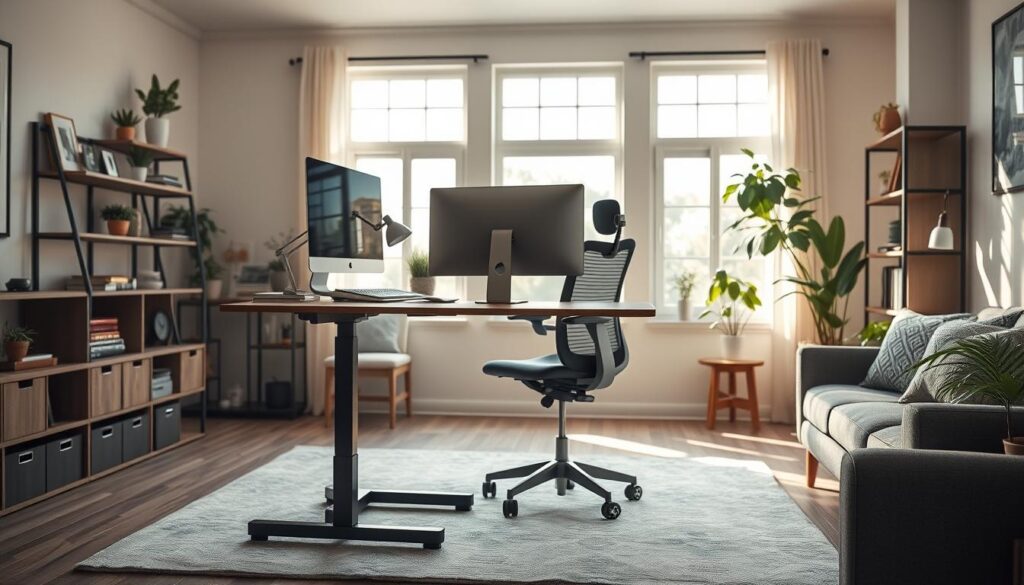
Comfortable and Ergonomic Seating
A good chair is essential for staying comfy and productive. Find an ergonomic desk chair with good lumbar support and adjustable height. Chairs with breathable fabric or mesh are also comfy.
“The right chair can make all the difference in your productivity and comfort.”
Storage Solutions That Blend In
Good storage keeps your space tidy. Choose multifunctional furniture like storage ottomans or coffee tables with storage. Shelves and bookcases also help keep things organized and add to the room’s look.
| Furniture Piece | Functionality | Aesthetic Appeal |
|---|---|---|
| Compact Desk | Saves space | Modern design |
| Ergonomic Chair | Lumbar support | Breathable fabric |
| Storage Ottoman | Storage and seating | Blends with decor |
By picking the right furniture, you can make a living room office that’s both useful and looks good.
Ergonomics for Productivity and Health
Ergonomics is key for better productivity and health at home. A well-designed workspace greatly improves how you feel and work all day.
Proper Desk and Chair Height
Having your desk and chair at the right height is essential. Your feet should be flat on the floor or on a footrest. Your knees should be at or below hip level.
The desk height should let you work with elbows at a 90-degree angle. This keeps your wrists straight, reducing strain.
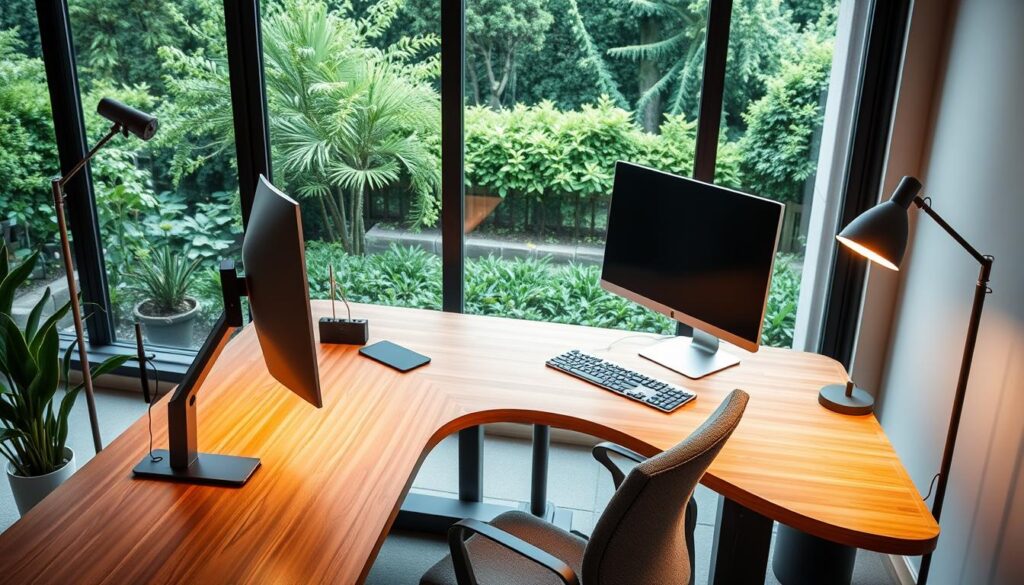
Monitor Positioning
Correct monitor placement is critical for eye health and posture. Place your monitor directly in front of you, about 20-25 inches away. It should be at a height where you look slightly down.
This setup lessens neck and eye strain.
Preventing Strain and Fatigue
Regular breaks and movement are key to avoiding strain and fatigue. Standing up, stretching, and moving every 30-60 minutes helps a lot. It lowers the risk of musculoskeletal disorders.
Using ergonomic furniture that promotes movement and good posture is also beneficial.
By following these ergonomic tips, you can boost your productivity at home and stay healthy. A healthy workspace is vital for a productive and comfortable work area.
Optimizing Technology Setup
Setting up a home office in your living room is more than just picking furniture. It’s about creating a space that works well with your tech. A good tech setup boosts your productivity and makes working from home better.
Cable Management Strategies
Keeping your workspace tidy is key. Use cable ties or cable organizers to manage your cables. This makes your space look better and keeps your gear safe.
- Use cord concealers to hide cables from view.
- Label your cables for easy identification.
- Route cables behind furniture to minimize visibility.
Internet Connectivity Considerations
A strong internet connection is a must for remote work. Place your router in a central spot for the best signal. If you have trouble connecting, think about getting a mesh network system.
Power Source Planning
You’ll need enough outlets for all your office gear. A power strip or surge protector helps manage your devices and protects them from power spikes.
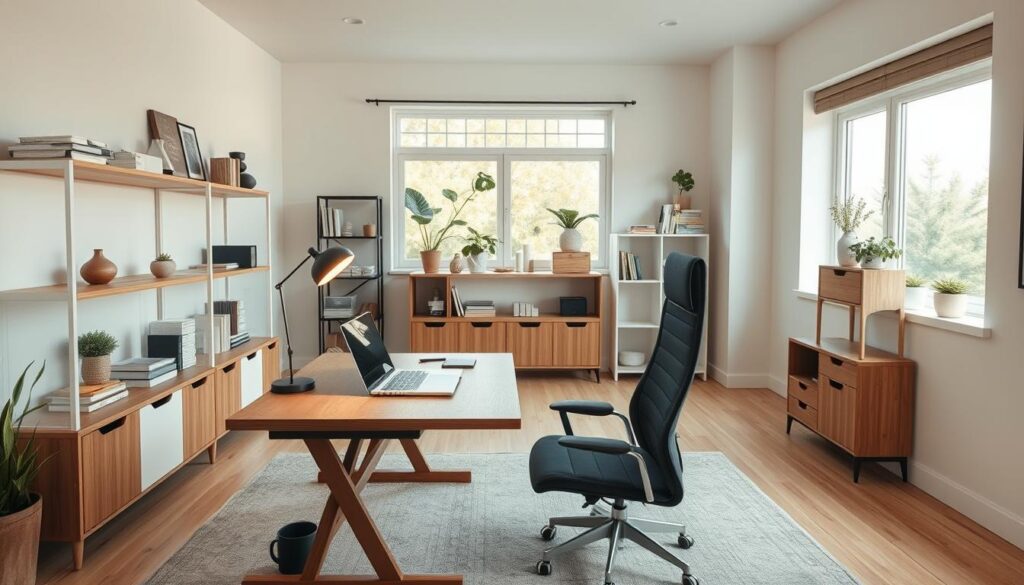
Lighting Solutions for Work-Life Balance
Proper lighting is key for a good workspace in your living room. It helps with both work and relaxation. A well-thought-out lighting plan can make your work better and help you balance work and life.

Task Lighting Essentials
Task lighting is vital for your workspace. Desk lamps are great for this, as they shine light right where you need it. Look for a desk lamp that you can adjust. This way, you can avoid glare on your screen.
Adjustable Lighting Options
Adjustable lighting changes your workspace’s feel and use. Dimmable lights let you change the light’s brightness. This helps reduce eye strain and boosts focus.
“Good lighting is key for productivity and comfort. It can make or break a room’s feel.”
Preventing Screen Glare
Screen glare is a big problem in workspaces, like near windows or lights. To avoid glare, place your screen at a 90-degree angle to the light. Or, use anti-glare screen protectors. Also, light-diffusing window treatments can soften natural light.
With these lighting tips, you can make a workspace that’s both useful and cozy. It will help you work better at home and make your room more efficient.
Incorporating Style and Aesthetics
Making your living room workspace stylish can make it more welcoming and useful. A well-designed area boosts your productivity and improves your home’s look.
Coordinating with Existing Decor
It’s key to match your workspace with your living room’s decor. Pick furniture and decor that fit the room’s style. For example, if your room is modern and simple, choose furniture that’s sleek and low.
Key Considerations:
- Match the color palette
- Select furniture that aligns with the room’s style
- Incorporate decorative elements that enhance the space
Color Psychology for Productivity
Colors can really affect your mood and how well you work. Some colors can spark creativity, while others help you relax. For a workspace, choose colors that help you stay focused and productive.
| Color | Effect on Productivity |
|---|---|
| Blue | Promotes calmness and focus |
| Green | Reduces eye strain and improves vision |
| Yellow | Stimulates creativity and energy |
Personalizing Your Workspace
Adding personal touches to your workspace can make it more fun and motivating. Include things like artwork, plants, or family photos to make it feel welcoming.
Tips for Personalization:
- Add plants for a natural touch
- Incorporate personal artwork or prints
- Use decorative storage solutions
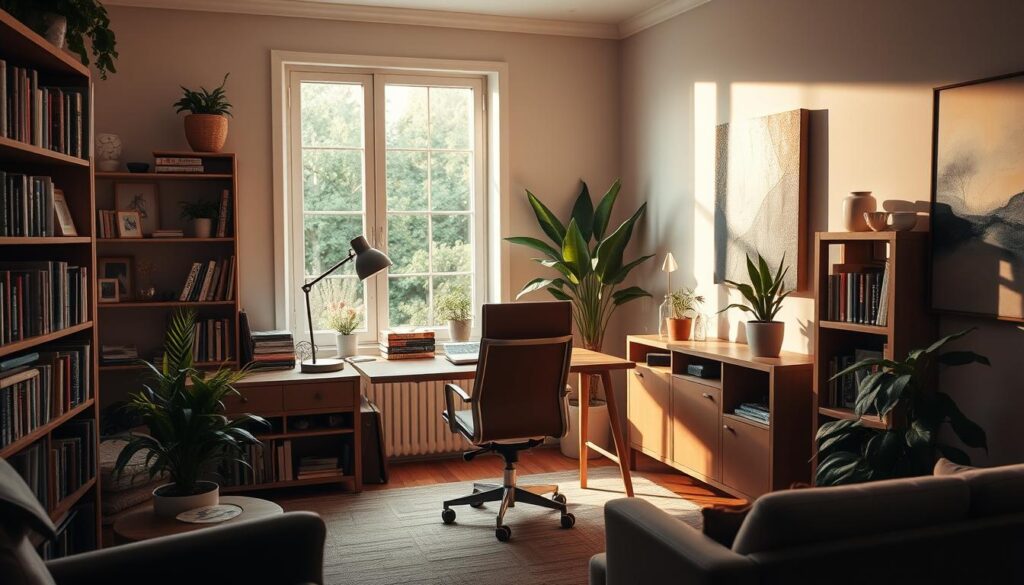
By adding style and beauty to your living room workspace, you can make a space that’s both useful and lovely. It will help you work better and feel better too.
Multifunctional Furniture and Space-Saving Ideas
Choosing the right multifunctional furniture is key for a functional living room workspace. When space is tight, pick pieces that do more than one thing. This helps keep your space clean and efficient.
Foldable and Convertible Desks are perfect for small living rooms. They fold up against the wall when not in use, saving floor space. Some can even turn into other furniture, like dining tables or console tables, making them super versatile.
Foldable and Convertible Desks
- Wall-mounted desks that fold down when needed
- Convertible desks that change into other furniture pieces
- Compact desks with built-in storage for cables and office supplies
Dual-Purpose Storage Solutions are also essential. Ottomans with storage, coffee tables with lift-tops, and storage cubes help keep your workspace organized. They offer storage and keep your room tidy and clutter-free.
Dual-Purpose Storage Solutions
Using vertical space is critical in small living rooms. Shelves, hanging organizers, or stackable storage units can boost storage without taking up floor space.
Vertical Space Utilization
- Wall-mounted shelves for books and decorative items
- Hanging organizers for bags, accessories, or office supplies
- Stackable storage units for maximizing vertical space
By using multifunctional furniture and smart space-saving ideas, you can make a living room workspace that’s both useful and looks good. The trick is to blend work and living areas smoothly, keeping your home cozy and welcoming.
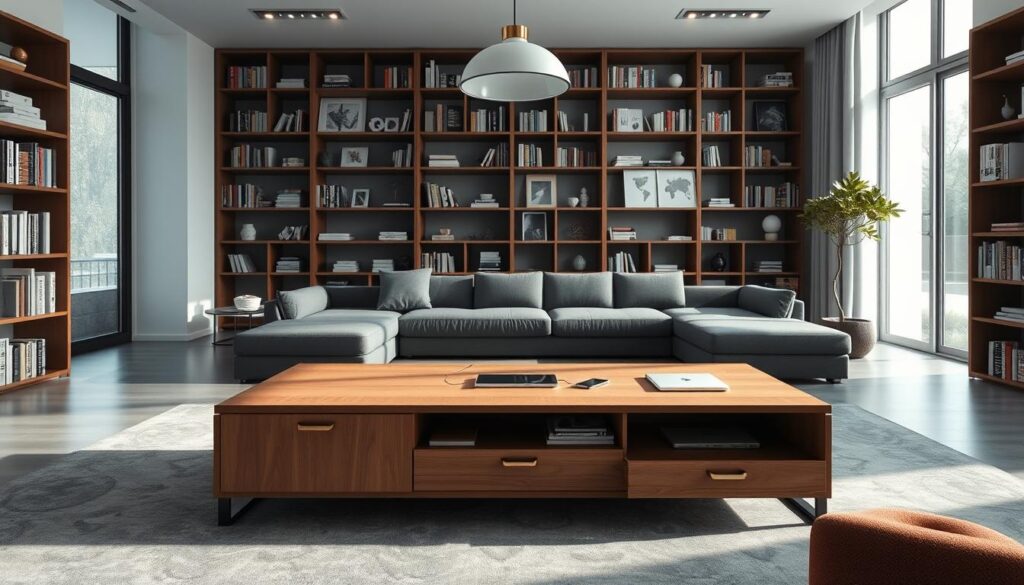
Conclusion: Maintaining Your Living Room Workspace
Creating a functional workspace in your living area is key for staying productive and feeling good. By using the strategies we’ve talked about, you can make working from home smooth.
To keep your living room workspace in top shape, set up a cleaning and organizing routine. Get the right furniture and lighting for work-from-home to stay comfy and efficient.
By mixing work and living spaces, you can make a space that’s good for both. Don’t forget to check and update your workspace often to keep it working well.
A well-thought-out living room workspace can really improve your work-from-home life. Follow the tips and strategies from this article to make a space that’s both productive and cozy.
